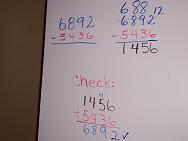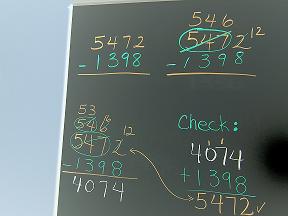Subtraction - Regrouping

The basic skill of subtraction with borrowing challenges some students young and old. The problem magnifies if it requires borrowing or regrouping across zeros or borrowing multiple times. When the traditional subtraction method does not seem to click, consider this alternative method. This works well with most secondary students and adult learners that did not master the skill earlier in school.
Let’s try: 6 8 9 2 – 5436 =
Always begin with the ones place. It reads two take away six. Hold up four fingers. Can you bend or take away six fingers? No.
Since you can’t take away six, we need to borrow. (Here is where the alternative method begins.) Instead of borrowing from the tens place, cross out the remaining numbers (689); decrease the crossed out number, 689, by one.

Notice the new numbers are written directly above the 689 in their proper columns. Now, the two becomes a twelve, and you are able to subtract. Notice the thousands and hundreds place stayed the same. Next subtract the tens, hundreds, and thousands.
Finally, CHECK using addition. Add the answer to the number subtracted. The sum should equal the top number. In math terms, add the difference (answer) to the subtrahend (the number subtracted) and expect to get the minuend (top number)
Now, let’s try: 5 4 7 2 - 1 3 9 8 =
Always begin with the ones place. It reads two take away eight. Hold up two fingers. Can you bend or take away eight fingers? No.
Since you can’t take away eight, we need to borrow. (Here is where the alternative method begins.) Instead of borrowing from the tens place, cross out the remaining numbers (547); decrease the crossed out number, 547, by one.

Notice the new numbers are written directly above the 547 in their proper columns. Now, the two becomes a twelve, and you are able to subtract. Notice the thousands and hundreds place stayed the same. Next, subtract the tens. Again, we need to borrow.
Cross out the remaining number, 54. Decrease the number by one. Write 53 directly above 54. Change the six to sixteen. Complete the subtraction process.
Let’s try another problem. Subtract 1898 from 5000.

Since eight cannot be subtracted from zero, cross out the remaining number, 500. Decrease by one, and write 499 above it. Can you see how decreasing 500 by one eliminates the confusion many students experience? Subtract.
Finally, always check your subtraction by adding the answer to the number you subtracted. The result should equal the top number.
A few tips:
When a problem is written horizontally such as 5000 – 1898, write the problem vertically.
The larger number is always written on top.
Let’s try: 6 8 9 2 – 5436 =
Always begin with the ones place. It reads two take away six. Hold up four fingers. Can you bend or take away six fingers? No.
Since you can’t take away six, we need to borrow. (Here is where the alternative method begins.) Instead of borrowing from the tens place, cross out the remaining numbers (689); decrease the crossed out number, 689, by one.
Notice the new numbers are written directly above the 689 in their proper columns. Now, the two becomes a twelve, and you are able to subtract. Notice the thousands and hundreds place stayed the same. Next subtract the tens, hundreds, and thousands.
Finally, CHECK using addition. Add the answer to the number subtracted. The sum should equal the top number. In math terms, add the difference (answer) to the subtrahend (the number subtracted) and expect to get the minuend (top number)
Now, let’s try: 5 4 7 2 - 1 3 9 8 =
Always begin with the ones place. It reads two take away eight. Hold up two fingers. Can you bend or take away eight fingers? No.
Since you can’t take away eight, we need to borrow. (Here is where the alternative method begins.) Instead of borrowing from the tens place, cross out the remaining numbers (547); decrease the crossed out number, 547, by one.
Notice the new numbers are written directly above the 547 in their proper columns. Now, the two becomes a twelve, and you are able to subtract. Notice the thousands and hundreds place stayed the same. Next, subtract the tens. Again, we need to borrow.
Cross out the remaining number, 54. Decrease the number by one. Write 53 directly above 54. Change the six to sixteen. Complete the subtraction process.
Let’s try another problem. Subtract 1898 from 5000.
Since eight cannot be subtracted from zero, cross out the remaining number, 500. Decrease by one, and write 499 above it. Can you see how decreasing 500 by one eliminates the confusion many students experience? Subtract.
Finally, always check your subtraction by adding the answer to the number you subtracted. The result should equal the top number.
A few tips:
When a problem is written horizontally such as 5000 – 1898, write the problem vertically.
The larger number is always written on top.
You Should Also Read:
What is a Fact Family?

Related Articles
Editor's Picks Articles
Top Ten Articles
Previous Features
Site Map
Content copyright © 2023 by Beverly Mackie. All rights reserved.
This content was written by Beverly Mackie. If you wish to use this content in any manner, you need written permission. Contact Beverly Mackie for details.




